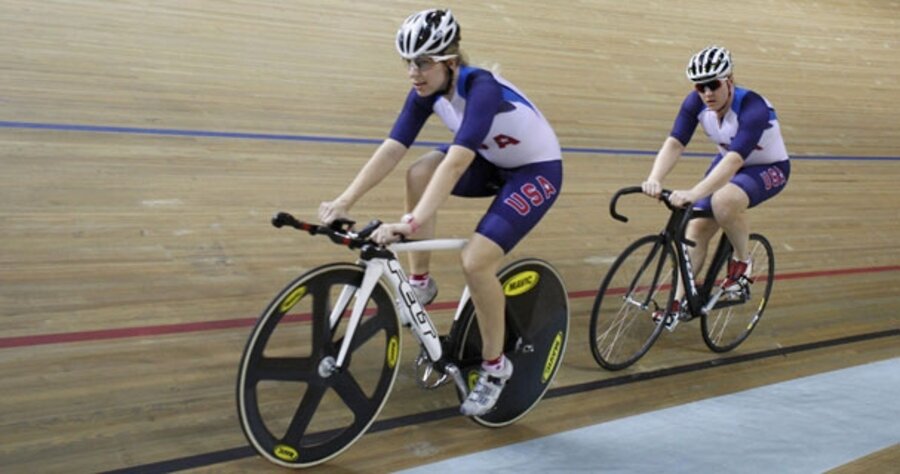Coming back from burnout
Loading...
| Beijing
Sarah Hammer was sitting on her sofa, watching the 2004 Athens Olympics, when she realized she had made a terrible mistake.
Until January of that year, she had been one of the most promising track cyclists in the world. But she quit.
At age 20, she was burned out. She had missed her own prom. She had never experienced waking up late. So she sold everything, down to the last pedal and tire, and started working at a bagel shop in Boulder, Colo.
“I was interested in finding what was exciting about living a normal life,” she says. Soon enough, she had the answer: nothing.
“I thought, ‘What happened?’ ” she says. “I had all these dreams.”
She does again: to win gold in Sunday’s individual pursuit – an event she won at World Championships last year.
Like many other Olympic athletes, Hammer found that from the ashes of aseeming ending often springs a new beginning. Of those, five-time Olympian Dara Torres is probably the most famous. She first qualified for the Games in 1984 and twice retired before coming back to Beijing, where she secured silver in the US women’s 4x100 meter freestyle relay and will race again Sunday.
Chinese fencer Luan Jujie has returned – 24 years after she won China’s first fencing gold in Los Angeles – to compete at age 50 for her adopted homeland, Canada. And then there is Sheila Taormina, who, at 39, is the first woman to qualify for the Olympics in a third sport, adding modern pentathlon to triathlon and swimming.
Hammer may be the baby among burnout survivors, but by 2004, she had been racing for 11 years – 17 if you count her exploits on a Big Wheel (which she does). “It was all I ever knew,” she says.
But now she knows something else: it’s a rare privilege to be paid to do what one loves.
And it’s clear she loves her sport.
“Sarah has the focus, intensity, and fire within that brings great results – everything she had before, but basically the dial turned up,” says her coach, Andy Sparks.
It is 2 o’clock on a sunny June afternoon when Hammer shows up to the $15 million Los Angeles velodrome, or indoor track.
After a doe-like handshake, she turns and tows her rolling suitcase silently into the empty bleachers. She is part jockey, part thoroughbred – clear glasses over her clear blue eyes, her massive, lycra-clad muscles rippling as her cycling shoes clip-clop on the floor. Visibly keyed up, she fiddles with her earphones. “I get so nervous, but once you set me in the starting block, it’s game on,” says Hammer.
That’s true even when there’s no one to watch but Sparks, a former pro racer whom she met during a photo shoot of Olympic apparel before quitting the sport. They are engaged to be married and united in an intense daily bid to shave each possible hundredth of a second off Hammer’s time.
It’s a rigid regimen of train, eat, sleep – 50 weeks a year. “If you miss one day of training, it haunts you,” says Hammer, who had been hard-put this year even to find time to visit her nearby 92-year-old grandparents until she celebrated Father’s Day with them recently.
“We came back solely for the purpose of giving it 100 percent,” she says. “Before I was riding just to ride.”
So she and Sparks made a pact: There would be no compromises in their pursuit of excellence. She overlooks no detail: She arrived in Beijing wearing a face mask, and while she has apologized and genuinely does not wish to offend, she still wears it in the athlete’s village on days “when I feel it’s necessary.”
Hammer even decided she would turn down free equipment if it wasn’t the absolute best money could buy. That commitment has been facilitated by the generous sponsorship of Brent Kay, a family friend from Hammer’s childhood and executive director of OUCH Sports Medical Center in her hometown of Temecula, Calif. Dr. Kay, says Sparks, has “made it possible for Sarah to sit in bed at night and not wonder if she can pay her bills, but rather what she can do to improve her training.”
“You can’t hope for best on race day,” Sparks says. “Success at this level comes with doing those small things ... even just making sure big things are done with a high degree of detail.”
She and Sparks pay $1,000 an hour to train in a wind tunnel and fine-tune Hammer’s aerodynamics. She talks about her starts as “the first 1/24th of my race,” dissecting the technique necessary as she powers around the steeply banked first turn, throws her bike side to side in a furious acceleration down the backstretch, and then settles into a gritty determination to overcome anything that would slow her down for the rest of the 3-kilometer (1.8-mile) race.
“Sometimes I just know: I’m not going to be beat today. Whatever is thrown my way ... I know I can rise to the challenge.”
Those have included a back injury that left her doubting if she would even make the Beijing team. There have been “many, many tears,” she says.
Part of what she’s learned since returning is not to be so “obsessed” with daily results. But her pride is obvious. “Did you hear my times?” she asks, beaming after inishing a grueling session. She rattles off her split times on the 250-meter track: 6.9 (shorthand for 16.9 seconds), 7.1, 7.3, 7.3, 7.3, 7.4. That’s 33 miles an hour.
She has no regrets about leaving her temporarily more sedentary lifestyle behind, however tough it’s been to make a comeback. “All of us sacrifice so much for these couple seconds of glory,” she says. “But it is so worth it.”
Christa Case Bryant contributed from Los Angeles.





